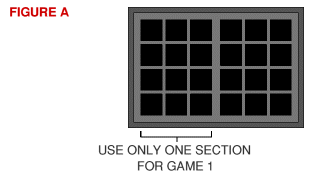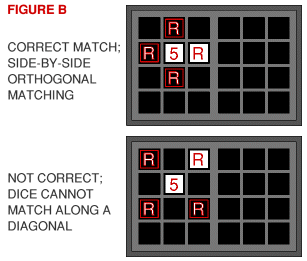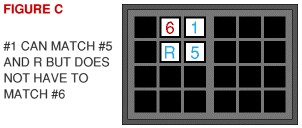
Uno Dice: Basic Version Rules
HOW TO PLAY GAME 1
Place all 24 dice in the dice bag. Each player in turn takes one die out of the bag and rolls it. The player who rolls the highest number (any letters rolled do not count) is the first player also called the STARTING PLAYER.
Note that the dice tray has 24 dice spaces in it and is divided into two halves. Only one half of the tray is used for GAME 1 (12 spaces). See FIGURE A below.
Put all dice back in the bag. The STARTING PLAYER draws one die out of the bag, rolls it and places it face up in any one of the 12 dice spaces in either half of the tray. If the Starting Player's roll is other than a number (0-9), the play as follows:
WD4 (WILD DRAW 4)- The Starting Player rerolls the die.
W (WILD)- The player to the left of the Starting Player calls the colour, then plays.
D2 (DRAW 2)- The player to the left of the Starting Player draws two dice and play passes to the next player on the left.
R (REVERSE)- The Starting Player plays first. Play continues to the right.
S (SKIP)- The player to the left of the Starting Player is "skipped" and play passes to the next player to the left.
After the STARTING DIE is placed in the tray, all players in turn (starting with the player to the left of the Starting Player, proceeding left) draw four dice out of the bag (three dice if five or six players play).
The player to the left of the STARTING PLAYER (unless a special die was rolled- see rule #3) rolls her dice on the table so that they can be seen by all players. The player looks at the dice to see if any of these can match the STARTING DIE already in the tray. The dice can match by either number, colour or letter in any combination.
EXAMPLES OF MATCHING: You may place a red 5 next to a red R. You may place a green D2 next to a yellow D2. You may place a blue 7 next to a red 7. You may place a green 3 next to a W, if it was previously declared to be green. The W and WD4 have no colour and may be placed next to anything.
If a match can be made, the player places the die in the tray, face up, directly adjacent to (side-by-side with) the Starting Die. The turn ends and the next player. The turn ends and the next player to the left (or right if an odd number of Rs have been played so far- see rules #3 and #10) plays and rolls her dice. See FIGURE B below.
If a player cannot match the die in the tray, she must draw one die from the bag and roll it by itself. If this roll now allows a match, it must be made. If no match can be made, then the player adds the die to her other dice. Then the next player plays.
Play proceeds in this manner to the left (unless an odd number of Rs have been played, in which case it proceeds to the right- see rules #3 and #10). After each player has one turn, a player always has the option of either rolling her dice at the start of the turn or not rolling them at all. But a player must always make a match if there is a play on the tray. FOR YOUNGER PLAYERS: We suggest that these players must roll their dice at the beginning of each turn. Reason- younger players will probably "play" with their dice between turns anyway.
As dice are added to the tray, sometimes a newly placed die must be placed next to two or more dice at the same time. In this case, the newly placed die must match at least one, but not necessarily all of the adjacent dice already in the tray. See FIGURE C below.
FILLING THE TRAY: After filling the 12 spaces on one half of the tray, keep one finger on the die which filled the tray and dump the rest of the dice from the tray into the bag. Play continues normally by playing on the single remaining die in the tray, and so on, until the tray fills up and must be dumped again.
SPECIAL LETTER DICE: The special letter dice are S, R, D2, W and WD4.
S (SKIP): When you play an S, the next player is "skipped" and loses her turn. Play continues directly with the player who would normally follow the "skipped" player.
R (REVERSE): When you play an R, the direction of play immediately reverses and continues in the reversed direction until another R is played.
D2 (DRAW 2): When you play a D2, the next player must draw two dice out of the bag, roll them and add them to her other dice. This player's turn is now over. Play continues with the next player.
W (WILD): You may play a W next to any die in the tray, even if you have another play among your dice. After playing it, you must declare what colour it is. It remains this colour until the hand ends or the die is dumped from the tray (when it is filled or there is a dice shortage- see rules #9 and #11).
WD4 (WILD DRAW 4): You may play a WD4 next to any die in the dice tray. However, you may not play it if you have another playable die among your dice. After playing it, you must declare what colour it is. It remains this colour until the hand ends or the die is dumped from the tray (when it is filled or there is a dice shortage- see rules #9 and #11). The action of a WD4 is to cause the next player to draw four dice, roll them and add them to their dice. This player's turn is now over, and play continues with the next player.
EMPTY BAG: Sometimes a player needs to draw dice out of the bag, but there are not enough dice remaining in the bag. In this case, the dice are immediately dumped fom the tray into the bag, leaving only the most recently played die in the tray. After dumping the dice in the bag, if there are still not enough dice to draw, then the player is considered "lucky" and does not suffer the full penalty.
GOING OUT: As a player plays her next to last die, the player must call out "UNO" (meaning "ONE"). This warns all players that the player may be able to go out on her next turn. If a player fails to say "UNO" by the time the player removes her fingers from the die being placed in the tray, any other player in the game may "catch" the player. If the player is "caught", the player must immediately draw two dice from the bag, roll them and add them to her other unplayed die. Play then continues. A player not saying "UNO" must be caught before the next player finishes her turn, or else she is "safe", in which case there is no penalty.
When a player plays her last die, the hand is over. Points are scored, the dice are placed back in the bag, and a new hand is started with the player to the left of the player who started the last hand. If the die ending the hand is a D2 or a WD4, the next player who would have played in the hand still has to take and roll two or four more dice from the bag as demanded by the relevant sections of rule #10.
SCORING: The player who goes out scores all the dice remaining in each of the other players' hands. PLAYERS MUST NOT CHANGE OR ROLL THEIR DICE UNTIL THEY HAVE BEEN SCORED. All numbered faces (0 through 9) score as their numerical value. The R, S and D2 each score as 20 points. The W and WD4 each score as 50 points. NOTE: If a player goes out before another player was able to take her first turn, then the player who did not get to play must roll her dice, so that those dice can be scored.
THE WINNER: Players keep a running total of the score. The first player to reach or pass 500 points is the winner.
TABLETALK: Since all players' hands are visible at all times, allowing tabletalk can bring a new, fascinating dimension to the game. Before beginning, players should agree upon whether to allow tabletalk.
TWO-PLAYER RULE: When two players play, the play of an R does not cause a reverse of direction. Instead it causes the other player to "skip" or lose her turn.
SCORING VARIATION: The game may be scored by keeping a running total of the points each player is caught with in his or her hand. When one player reaches 500 (or any designated amount), the game is over and the player with the least number of points is declared the winner.




Author and editor: Kade "Archer" Hansson;
e-mail:
kade_fh@postoffice.utas.edu.au
Last updated: Sunday 10th January 1999
Game devised by International Games Limited. Uno is a registered trademark of International Games Limited. All rights reserved.
This text was adapted from the official IGL Uno Dice Rules.




